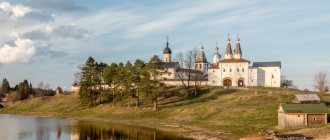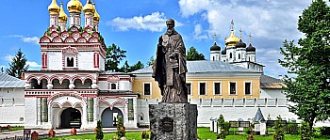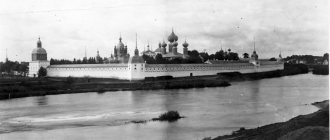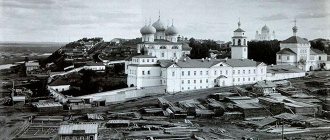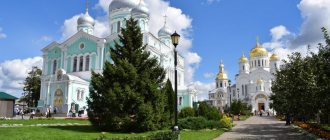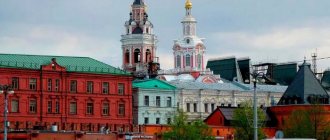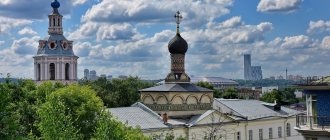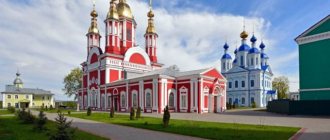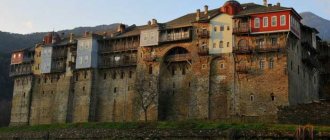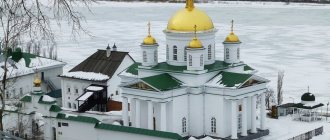Illness of the Pious Prince
A legend is associated with its foundation, which, as the inhabitants of the monastery assure, did not arise out of nowhere. It tells that the pious prince of Chernigov and Debryansky Roman Mikhailovich, who ruled these regions at the end of the 13th century, once suffered a serious illness - he began to go blind, so much so that every day the white light in his eyes faded away. At that time there were no doctors at the prince’s court, and God forbid to turn to sorcerers and healers! - a baptized person. What can he hope for? Only by the grace of God.
So the prince sent the archimandrite of the local monastery to Kyiv to bring him the miraculous icon of the Mother of God, through prayers before which healing had been granted to the suffering more than once. The prince’s word is the law, and the man of God set out on the road, taking with him five monks who were humble in heart, but very strong in flesh - times were turbulent, and anything could happen on the road.
Trinity Sevsky Monastery[edit]
In the local list of the city of Sevsk for 1519, the Sevsky Trinity Novodevichy Monastery was mentioned. Nothing is known about the fate of the first women's community, except that the foundation of this monastery was an almshouse located at the cemetery church in the city of Sevsk. The cemetery where it was located was called the “Tatar massacre” and was separated from the city by a moat. In the beginning. In the 17th century, the monastery was burned and revived again thanks to the nuns of the Putivl Holy Spirit Monastery, devastated by the Poles in 1612, who came to Sevsk and brought with them the icon of the “Molchanskaya” Mother of God. With the increase in monastics and the influx of pilgrims, the old wooden church in the name of the “Nativity of the Mother of God” could no longer accommodate all the worshipers, so a second wooden church in the name of the “Life-Giving Trinity” was built. At the beginning of the 18th century, the monastery with two churches, wooden cells and a bell tower with four bells was surrounded by an alder palisade.
Address:
Bryansk region, Sevsky district, Sevsk, st. Lenina, 10
Miracle Revealed on the River Bank
The princely envoys were already sailing back along the Desna River and carrying the treasured icon with them, when suddenly a certain misfortune befell them - the boat, which had so vigorously cut through the river streams, suddenly froze in place, stopped by an unknown force. No matter how hard the rowers tried, no matter how hard they leaned on the oars, they could not move either up or downstream. There was nothing to do, we somehow made it to the shore and spent the night.
In the morning they missed it - there was no icon, it was gone! They rushed to search, trying not to think about what reward awaited them for such service. But God is merciful - the loss was found. They found her among the branches of a mighty oak tree that stood at the bend of the river. Although the monks were timid, they did not dare to touch the image, but hastened to inform the prince about the miracle that had happened. He did not hesitate to appear and, falling to his knees, prayed for a long time. Then everything happened according to the laws of the genre - the prince saw the light and ordered to found a monastery on this place, which has survived to this day and is known as the Svensky Monastery.
By the way, an interesting detail - in ancient times the river Sven, which gave its name to the monastery, was called Svin, and the monastery, accordingly, was called Svinskaya, which was very dissonant and gave rise to inappropriate witticisms. To correct the situation, in the 17th century it was decided to change only one letter in its name, but at the same time it was necessary to rename the entire river. Since then, the Sven River appeared on maps, and with it the Svensky Monastery.
Holy Cross Sevsky Convent[edit]
The Sevsky Holy Cross Convent was opened on May 18, 2000 on the site of the parish of the Holy Cross Church, after which it received its name. The nun (since 2007 - abbess) Afanasia (Lichayeva) was appointed abbess.
The emergence of the Exaltation of the Cross wooden church dates back to the 17th century. On the city plan of 1808, this is already a stone temple. The modern stone temple was built at the expense of the merchant P.I. Nesterova. There were two chapels in it: in honor of the Exaltation of the Cross of the Lord and in the name of the Holy Great Martyr George the Victorious.
Under Soviet rule, the Church of the Exaltation of the Cross remained for a long time the only functioning temple in Sevsk and was not destroyed.
Address:
Bryansk region, Sevsky district, Sevsk, st. Nekrasova, 24
Telephone:
8-(48356) 9-14-00
Creation of Saint Alypius
The icon, which so miraculously healed the prince, became the main shrine of the newly formed monastery. On a wooden board measuring 68x42 cm, the Most Holy Theotokos is depicted sitting on a throne and holding in her arms the Eternal Child, who raised his right hand in blessing. On both sides of the throne are the saints of the Pechersk wonderworkers Theodosius and Anthony.
The authorship of the icon is attributed to the Monk Alypius, who studied with Byzantine masters who worked in 1088 at the Kiev Pechersk Lavra. These details are known due to the fact that after the revolution the icon entered the collection of the Tretyakov Gallery and has survived to this day.
The Holy Dormition Svensky Monastery, formed among the dense forests of Bryansk, became the cradle for many desert-dwelling hermits. It is known that dozens of his monks, having asked the abbot for a blessing, secluded themselves from the world in impenetrable thickets, building themselves miserable cells and spending their lives in fasting and prayer. They appeared at the monastery only for confession and communion. This form of religious asceticism became widespread at the beginning of the 18th century and then remained for many years.
Svensky Dormition Monastery of Suponevo Diocesan monasteries of the Russian Orthodox Church
This icon, measuring 68 by 42 cm, depicts the Most Holy Virgin, the Mother of God, seated on a golden throne and holding on her lap the Eternal Child, who raised his hand for blessing. On both sides of the throne, on special elevations, stand the Pechersk miracle workers: on the right side of Feodosia, on the left - Anthony. On the scroll of the Monk Theodosius is inscribed: “Master, Lord God... reward the house of Your Most Pure Mother with me, your servant Theodosius, and establish it motionless until the day of Your terrible judgment in praise and glorification of You.” On the scroll of St. Anthony you can read: “I pray that you, children, maintain abstinence and are not lazy; Imams are the Lord’s helper in this.” Having heard about the miraculous disappearance and discovery of the brought icon, Prince Roman with his relatives, close boyars and Bryansk clergy went with enthusiasm to the place where the icon was found. Approaching the oak tree, he prayed and exclaimed with tears: “Oh, Most Holy Lady, Lady, Virgin, Mother of God! Hear the voice of my prayer and give me insight into my eyes!” And at that same hour he regained his sight, beginning to see better than before. After prayers of gratitude, the prince, promising the Mother of God to give Her all that he now sees around him, began to harvest wood with his own hands for the construction of an ordinary temple. The oak tree on which the miraculous icon was found was divided into parts and distributed to those who wished. Later, at the site of the appearance of the icon, a stone pillar was erected, decorated with a copy of this icon.
The wooden church built in honor of the Dormition of the Mother of God became the center of a desert-dwelling monastery, for the arrangement of which Roman Mikhailovich allocated enough gold and silver. Subsequently, the founder of the monastery himself was buried in this temple. The monastery was inhabited by 70 monks, surrounded by a rampart and a palisade of sharpened logs.
With the transition of Bryansk to the Moscow state, the Svensky Monastery, thanks to its miraculous icon and the position of a cultural center in the ancient Bryansk district, quickly became an extraordinary monastery. The Moscow government appreciated its importance in strengthening the borders of the Russian state. Therefore, the tsars, Ivan the Terrible, Fyodor Ioannovich, Boris Godunov, Mikhail Fedorovich, Alexei Mikhailovich, Fyodor Alekseevich, Peter I, Empress Elizaveta Petrovna, Patriarchs Filaret and Joseph, boyars Yuryev, Romanov, Nagiye and others in every possible way contributed to the strengthening of the monastery, endowed it with contributions and provided benefits. The pious Ivan the Terrible was especially generous, hoping with rich contributions to atone for his personal losses and atrocities. Under Ivan the Terrible, the construction of stone churches began instead of wooden ones. The Assumption Cathedral of the monastery was built in 1578. It was built by the Tver master Gavriil Dmitrievich Makov. The cathedral had a majestic seven-tier carved iconostasis, 33 meters high. It was covered with silver and gold leaf. The upper four tiers of icons were human height. Many icons were framed with silver frames, crowns and precious stones. The carved columns were also impressive, seemingly completely through. The pediments of the church were also decorated with iconography. On May 19, 1566, construction began on the church in the name of the Pechersk wonderworkers Anthony and Theodosius. But a year later, when construction was almost completed, the stone vault collapsed. By order of Abbot Sergius, the rubble was cleared and construction continued. The new temple was pillarless, single-domed, rectangular in shape, with one apse, with a warm refectory, cellars and a bread room in the basement. Contrary to the general rule, the altar part was built not in the east, but in the south. The architecture of the church reflected the forms of Moscow-Suzdal architecture. The harsh appearance of the temple was softened by decorative window frames of the second tier and cornices.
Around the same time, a stone bell tower was built, for which Ivan the Terrible donated two bells of 40 and 200 pounds.
In subsequent years, the Svensky Monastery was destroyed several times. In 1583, during an attack on Bryansk by a detachment of the Vitebsk governor Pats, all the monastery wooden buildings, icons, books and letters of grant were burned. Hiding in the forest, the abbot and the monks managed to take away with them only the miraculous icon.
The Time of Troubles turned out to be the most difficult period in the history of this holy monastery. During the long siege of the city in 1607, the monks and residents experienced terrible hunger. And at the same time, history tells that, along with others, at the head of the patriotic movement of the townspeople were the Svensky abbot Cornelius and the archpriest of the Intercession Cathedral Alexy, who called on residents to selfless defense of the city and its shrines, patience in enduring disasters and courageous struggle on the fortress walls. These two elders and the builder of the Svensk monastery Barsanuphius decorated with their signatures the famous act of election of Mikhail Fedorovich Romanov as Tsar in 1613.
On January 9, 1664, it was devastated and plundered by the Crimean Tatars. “Crimean military men came near Bryansk,” it was reported in the monastery records, “and stood in the House of the Most Pure Mother of God, and in the end they destroyed the monastery and burned the churches.” Due to the complete ruin of the monastery, Tsar Alexei Mikhailovich freed it from previous arrears and Yam taxes.
Of the new buildings in subsequent years, the three-domed Sretenskaya Gate Church was significant. Officially it was believed that it was erected in 1694 under Peter I, but in the book of contributions it was mentioned as early as 1678. Archimandrite Hierotheus said about its location in his famous book: “The Sretenskaya Church was built on the place where the blind Grand Duke Roman Mikhailovich, who walked from Bryansk with the sacred cathedral to the miraculous revealed Pechersk Icon of the Mother of God, through prayer, received the first relief from illness and blindness and saw the path; and where it was placed in memory of this mercy of the Lord, there was a cross.”
The church was two-story: the passages and passages to the monastery made up the first floor. The church itself was located on the second floor. Its forms were sustained in that peculiar Russian-Ukrainian spirit of the 17th century, about which some said that the style was brought from Russia to Ukraine, others - vice versa. But what was certain was that the baroque forms of the church were very picturesque and elegant.
But individual buildings could not overshadow the picture of the plight of the Svensky Monastery. Therefore, the tsarist government had to take urgent measures to correct the situation. During the struggle of the Moscow state with the Polish-Lithuanian Kiev-Pechersk Lavra, complaining to the Russian sovereigns about the insults and devastation caused to it and its possessions from the endless raids of its western neighbors, it repeatedly asked for some kind of refuge in the Moscow aisles. In 1680, sending a delegation to the Tsar with a petition, it specifically indicated “to have a refuge in your Great Russian Great Power until a time of peace, such as at Bryansk or Trubchevsk.” In his request, referring to the now considered forged charter of Grand Duke Andrei Bogolyubsky, according to which “the Bryansk, Novgorod (Seversky), Chernigov, Yeletsky monasteries were subject to the area of the Kiev-Pechersk monastery.” And Tsar Fyodor Alekseevich, well aware of the true position of the Svensky Monastery, on March 28, 1681, with his obedient letter, assigned it to the Kiev Pechersk Lavra. The Kyiv hieromonk John Maksimovich (glorified among the saints) was ordered to describe the entire household and property of the Svensk monastery with estates, livestock and grain supplies.
In addition to the churches, the monastery had 29 cells with 90 monks and novices living in them.
Closer to the fence were outbuildings: a horse yard with 114 horses and 16 foals, a barnyard with 57 cows. Two hotels were built for guests and pilgrims, one of which was intended for Greeks coming to the Svenska Fair.
The final transfer of the monastery to the Kiev Pechersk Lavra was legalized by the royal grant of 1682, according to which the monastery became known as the Novopechersky (Svensky) Monastery. In 1742, the abbot of the monastery beat Empress Elizabeth Petrovna with his forehead, asking for help in the construction of the temple, since all the monastery incomes since the time of Peter I were taken “for the wars with the Swedish crown and the Ottoman Party.” The petition was heard in the Senate, in the presence of the queen herself, after which a request for the required amount was sent to the Kiev Pechersk Lavra. Meanwhile, the Svensk monks carefully toured the monasteries, trying to find a model to follow. I liked the Donskoy Monastery Cathedral, somewhat similar to the old collapsed Assumption Cathedral of my native monastery. And in 1747 they asked the architect N.A. to draw up a project and estimate. Michurin, who was at that time in Kyiv, where he was building a house to receive the Empress.
The foundation of the temple was founded on July 30, 1749, but construction was completed only in 1758. The new Assumption Cathedral now had two chapels: in the name of St. Zechariah and Elizabeth and in the name of the apostles Peter and Paul. It was a huge, five-domed and apseless temple with straight-walled facades that had a semicircle with ten columns on the west, and a risalita on the other three sides. The majestic seven-tier iconostasis of the 17th century was also transferred to the cathedral. In the altar there was another ancient iconostasis, 22.72 m high, which decorated the mountainous place. At the Assumption Cathedral, new buildings in the Svensky Monastery were not completed. On June 10, 1734, Governor Barsanuphius asked the Synodal Treasury for permission to dismantle the dilapidated Transfiguration Church above the western fair gates and build a new one in its place. The construction of this one-domed church at the expense of the Bryansk merchants lasted eight years. It was consecrated on July 29, 1742. This temple was a common work of architecture of the 18th century, when a gradual transition from Baroque to Classicism forms was planned. The gallery, covering the first floor on three sides, gave the church solemnity and majesty. It offered a unique view of the surrounding area. Changes even affected the bell tower: it was built on and supplemented with a new bell of 300 poods, cast in the spring of 1749 by Moscow master Afanasy Prokhorov especially for the Svensky Monastery.
The memorable place of the monastery was a small stone house, standing opposite the bell tower, not far from the Assumption Cathedral. According to local legends, Peter I stayed there during his stay on October 22–24, 1708 in Bryansk. His arrival was caused by the need to check the city fortifications and monitor the movement of the Swedish army to Starodub and further to Ukraine. Having learned in the monastery about the betrayal of Hetman Mazepa, he went to the village. Cellars to prevent the consequences of betrayal. After the Battle of Poltava, he came to the monastery again, where he served a prayer service of thanks for the victory. On the northern side of the house the royal coat of arms was nailed, and under the roof itself from afar one could see the inscription: “The transformer of Russia repeatedly stayed in this house.”
With the construction of a stone fence in 1764, about 800 meters long and 5.5 to 8 meters high, the Svensky Monastery received its architectural completion. This fence, cut through by pilasters and embrasures, had the shape of an irregular octagon with six towers, ranging from eight to twelve meters in height. The Svensk monastery was also a large landowner. Within the Bryansk district, since the 16th century, she owned six villages in Podgorodny Stan, thirteen in the Batagovskaya volost, six in Pyanovskaya. And according to the revision of 1744, 37 villages and 16 thousand serfs were already indicated. The monastery also had its own farmsteads in Bryansk and Karachev. The peasants cultivated the arable land, looked after the crops, cleaned the ponds, cut down and transported the forest, etc. After all, the Svensk monks had a kvass brewery, a fish hatchery, a mill, an apiary, a forge, fulling mills and even their own pier. To top it all off, the peasants also paid rent in oil, honey, mushrooms, canvas and money.
After the secularization of the monastic lands of the monastery in 1764, only a personal plot, ten acres of arable land, a vegetable garden, a garden and a meadow for grazing were left. And very soon the Svenese inhabitants felt considerable financial difficulties. Things got to the point that Abbot Heraclius began to ask to reduce the number of monks to twelve people. But he was refused. The maintenance of the monks became increasingly meager, and the monks began to leave the monastery without permission, looking for a better life for themselves. Most often they went to Mount Athos and Moldova. Changes also affected the temple in the name of the Pechersk wonderworkers Anthony and Theodosius, which collapsed from disrepair in 1677. During the construction work, the middle pilasters were destroyed when making new windows. In 1806, an extension was made to the previous entrance, on the left, to expand the sacristy. And in 1932, the ancient entrance was finally sealed. In 1807, a chapel was built from the former refectory in memory of the appearance of the miraculous Svensk Icon. The dilapidated gable roof was replaced with a semicircular one in 1860. Like all holy monasteries, the Svensky Monastery was not only a stronghold of faith, but also a center of spiritual culture and enlightenment. According to the inventory of 1681, there were 115 books in his library. The 1755 inventory listed 338 books. In the last one. The main church inventory of 1893 already listed about 1,300 books, among which were many manuscripts, early printed books from the 16th-18th centuries, books on the history of the church of Russia and Byzantium, chroniclers, etc.
Many students and followers of Paisius Velichkovsky were associated with the Svensky Monastery, whose great merits in the revival of Orthodox spirituality in the second half of the 18th century became the basis for classifying him among the saints. Among them were Hieromonk Afanasy (Stepanov), Schemamonks Afanasy (Okhlopkov) and Afanasy (Zakharov), Hierodeacon Anastasy and others, who later became famous for their desert life and senile activity. Among these followers, Schema-Archimandrite Moses, who was in 1809–1811 a novice of the Svensky Monastery, and later the governor of the Kozelsk Optina Monastery, stood out especially.
At the appropriate level there were also ordinary spiritual brethren - talented, hardworking people who knew a lot and were able to do a lot.
In the early 1900s, the Svensky Monastery, numbering one hundred monks, owned 80 acres of arable and meadow land, seven acres of an orchard, which was its main source of income. The fixed capital of the monastery was then 40,980 rubles.
After the famous decree of 1918, the famous Svensky Monastery began to live out its last days.
At first, the service was held in the Assumption Cathedral and the church, the miraculous icon of Our Lady of Svensk was transferred to the Main Science of the People's Commissariat of Education for restoration, from there - for eternal storage in the Tretyakov Gallery, and on September 11, 1926, the entire former monastery was transferred to the Gubernia Museum.
The vile deed was completed by a brigade of demolitions under the leadership of Ya.P. Rykhlov, who blew up the Assumption Cathedral in 1930. A terrible sight appeared before the eyes of eyewitnesses: domes flying into the sky, mountains of building debris, tombstones from the monastery cemetery erased from the face of the earth what was the main beauty of the Svensk monastery. The explosion damaged the church in the name of the Pechersk miracle workers Anthony and Theodosius and the bell tower. And even earlier, the house of Peter I was dismantled into bricks.
In the 1970s, they finally began to restore the monastery. And in 1988, the former monastery, which became a branch of the Bryansk Regional Museum of Local Lore, opened its gates to visitors for the first time.
In 1992, with a gathering of people at the Svensky Monastery, a prayer service was served on the occasion of the return of the monastery to the Russian Orthodox Church.
Patronage of the formidable king
The first stone building of the monastery, and at the same time the surrounding area of Bryansk, was the Assumption Cathedral, built by order of Ivan the Terrible. It is known that in the nature of the king, demonic cruelty was surprisingly combined with extreme religiosity. Attaching cruelty to the execution of innocent people, he could then stand all night long in prayer for the repose of their souls.
In preparation for the Livonian War, the pious sovereign did not skimp on contributions to the holy monasteries. He did not bypass the Assumption Svensky Monastery, which at that time was both a fortified fortification structure and an important spiritual center. Archival documents have survived to this day, testifying to the donations he repeatedly made. In particular, in 1561, the Svensky Monastery (Bryansk) received a significant amount from him on the occasion of the death of his wife Anastasia. A little later, they contributed money for the construction of a temple in honor of the Pechersk wonderworkers Anthony and Theodosius.
Gorno-Nikolsky Monastery[edit]
Gorno-Nikolsky Diocesan Monastery in Bryansk, operating. Founded as a men's church on October 7, 2002 through the transformation of the parish of the Gorno-Nikolskaya Church. Two small brick buildings were built near it. Has diocesan status.
Placed on a hill in the historical core of the city of Bryansk opposite Pokrovskaya Mountain. In ancient times, there was a veche square nearby. In common parlance, the church was called “Upper Nikola” to distinguish it from the Assumption Church (not preserved) in Nizhnyaya Sloboda, which was called “Lower Nikola”.
Address
: 241000, Bryansk, st. Arsenalnaya, 8
Telephone
: 8(4832) 74-65-32
Raids of foreign adversaries
But apparently, the Lord did not bless the donations of the murderer king - in 1583, the Lithuanians, with whom he waged war, captured the Svensky Monastery, and, having plundered everything that could be taken out, they burned it. Miraculously, only the Svensk Icon of the Mother of God survived. After this, the monastery was revived through long and hard work, but in 1664 God’s wrath fell upon it again - this time it became the prey of the Crimean Tatars.
This time, it was easier to raise the monastery walls from the ashes, since three years earlier the monastery was assigned to the Kiev Pechersk Lavra, and from there all possible help came to the Bryansk region. Thanks to her, on the territory of the monastery in 1679, the gate Church of the Sretensky Church was erected, which has survived centuries and has survived to this day.
Resurrection Karachevsky Monastery[edit]
Karachevsky Resurrection Monastery (Tikhon's Hermitage) is a male monastery of the Bryansk diocese of the Russian Orthodox Church, founded in late. XVI century monk Tikhon.
Since 1680 it was assigned to the New Jerusalem Monastery, in 1764 it was abolished, the temple was turned into a parish. Restored in 2004. The monastery is located in the village. Berezhok of the Karachevsky district of the Bryansk region, on the left bank of the Snezhet River, dominates the surrounding landscape and is visible at the entrance to the city from Bryansk.
Address:
242500, Bryansk region, Karachevsky district, village. Berezhok, lane Embankment, 18A.
Priest's phone number:
8-910-234-11-95
Tel/fax:
(48335) 9-53-23 (on duty)
Visits of crowned heads
Revived from the ashes, the Svensky Monastery remembers the visits of many royal persons. It is known that Peter I visited it in 1708 and even stayed overnight. The house in which the sovereign spent the night survived until the revolution, and it was shown to all visitors as a historical landmark. Another witness to the royal visit is the oak tree planted by the monks in honor of this event, which still stands to this day, also attracting the attention of numerous pilgrims and tourists.
During one of her travels, Empress Catherine II also visited the walls of the Svensky Assumption Monastery. Finding his main temple in a very dilapidated condition and requiring immediate repair, she donated six thousand rubles, with which it was soon completely rebuilt. A more comfortable, dry and high place was chosen for him in the center of the monastery.
Until the beginning of the 20th century, the Svensky Assumption Monastery (Bryansk) lived in peace and prosperity. As before, his treasury received generous donations from God-loving citizens and persons of the reigning house. A fair, one of the largest in the western part of Russia, was noisy near the walls of the monastery, and God-loving monks offered prayers for the Tsar and the Fatherland. This continued until 1917.
Abbots, governors
- Sergius (mentioned ca. 1567) abbot.
- …
- Isaiah
- Jonah II
- Paul
- Sylvester
- James I
- Varlaam II
- Mark I
- Barsanuphius
- Job II
- Jonah III
- James II
- Theodosius I
- James III
- Hermogenes (mentioned 1655 - mentioned 1657)
- James IV
- Mark II (mentioned 1659)
- Barnabas (Glybotsky) (mentioned 1664)
- Nicodemus (? - 1672) abbot.
- Filaret (Levshin) (1673 - September 2, 1679)
- Markell, Archimandrite
- Nikon I, archim.
- St. John (Maksimovich) (ca. 1681 - 1684)
- Strength (Zharovsky) (1685 - 1699)
- Afanasy (Mislavsky) (mentioned 1701)
- St. Philofey (Leshchinsky) (1701 - 1702)
- Serapion (1702 - 1704) Hierom.
- Anthony (Tarasevich) (1705 - 1710)
- Modest (Ilnitsky) (mentioned 1710)
- Barsanuphius (Rostotsky) (mentioned June 10, 1734)
- Joel (Savitsky) (mentioned 1738)
- Gennady (Vasinsky) (mentioned 1744 - mentioned 1745)
- Luka (Belousovich) (1745 – mentioned 1749)
- Gervasius (c. 1750 - September 13, 1752)
- Hierotheus (1752 - 1755)
- Ignatius (Voitsekhovich) (+March 23, 1761)
- Irakli (Lyatoshevich) (1761 - January 10, 1766)
- Callistus (January 10, 1766 - mentioned 1768)
- Palladium (April 3, 1770 - July 7, 1787)
- Modest (October 14, 1787 - October 22, 1796), elevated to archimandrite and appointed abbot to the Oryol Assumption Monastery
- Nikon (October 22, 1796 - October 16, 1797), elevated to archimandrite and moved as abbot to the Tolga Monastery
- Eleazar (March 20, 1798 - September 10, 1798), moved by abbot to the Bryansk Peter and Paul Monastery
- Theodosius (September 10, 1798 - October 19, 1799), one of the abbots of the Bryansk Peter and Paul Monastery
- Manuil (Korchak-Kotovich) (March 4, 1800 - 1801), elevated to archimandrite and appointed abbot to the Oryol Assumption Monastery
- Israel (Zvegintsev) (March 25, 1801 - 1801), left for St. Petersburg as governor of the Alexander Nevsky Lavra
- St. Filaret (Amphitheaters) (March 11, 1802 [2] - October 10, 1804)
- Dionysius (Tsvetaev) (December 25, 1804 - October 22, 1805)
- Ambrose I (20 May 1806 - 1808)
- Ambrose II (October 31, 1809 – July 9, 1833)
- Sergius (August 6 - August 22, 1833)
- Dometius (November 12, 1833 - January 2, 1835)
- Venedikt (Kurkovsky) (June 24, 1837 - April 1839)
- Christopher (Emmaus) (June 24 - July 1837)
From 1924 to 1992 the monastery was abolished
- Nikodim (Aniskin) (October 16, 1992 - October 27, 2010)
- Mitrofan (Okhalov) (May 30, 2011 - June 7, 2012)
- Alexy (Tyurin) (May 29, 2013 - December 9, 2020)
- Tikhon (Kolesnyak) (from December 10, 2021 [11]), acting
The coming of hard times
From the beginning of the twenties, the Bolsheviks who came to power began to gradually but systematically close the monastery. When a campaign to confiscate church property swept across the country, allegedly aimed at fighting hunger, everything that was of interest to the new government was removed from the monastery.
Church utensils collected there over many centuries were taken out of churches, bells were removed and sent for melting down, and gold and silver frames were mercilessly stripped from icons. It seemed that the times of the Lithuanian and Tatar invaders had returned. Systematic looting continued until 1926, after which the Svensky Monastery was closed.
The mortal sin of Captain Rykhlov and everyone who was with him
The next stage of destruction of this historical and cultural monument came in 1930, when, by order of the city authorities, most of the monastery buildings were demolished. The Assumption Cathedral, so successfully rebuilt with donations from Catherine II, was also blown up. The blast wave also damaged the nearby temple of the Pechersk Wonderworkers, leaving only the lower tier of the previous building. The Svensky Assumption Monastery (Bryansk) ceased to exist.
This act of vandalism was committed by a group of Soviet bombers. History has preserved the surname of their commander - Captain Rykhlov. For many years he is no longer alive, and one can only hope that at the hour of his death the Lord sent him repentance for what he had done and did not allow him to depart to another world with a soul burdened with this terrible sin.
Ruins returned to people
But the wheel of history does not stand still. Having swept across the country with all the hardships that befell it in the 20th century, in the end it plunged Russia into the stormy ocean of perestroika. In 1992, the Svensky Monastery (Bryansk) was returned to the jurisdiction of the Church. By this time, of all the previous buildings, only the Sretenskaya and Transfiguration churches, which required major repairs, had survived, as well as the remains of the monastery walls and several former economic buildings that were in disrepair.
Other buildings were destroyed, and not even a trace remained of most of them, and in the surviving ruins it was difficult to recognize the former Svensky Monastery (Bryansk), known from archival documents. The photos published in the article give an idea of the scale of the work carried out.
Pokrovsky Klimovsky Monastery[edit]
The Old Believer Monastery was founded in 1765 by Hieromonk Mikhail Kalmyk instead of the Pokrovsko-Vetkovsky Monastery that had existed since the 1690s, abolished when the Old Believers left the Branch. Officially established on April 22, 1768. Since 1847 - Edinoverie.
In the 19th century partially rebuilt in stone, had 3 churches, a chapel, cell and service buildings, a hotel, and a fence. Closed in 1923, partially destroyed and rebuilt, the fence was dismantled; the buildings housed children's educational institutions and a state farm. In the 1990s, both churches and several buildings were transferred to the Russian Orthodox Church, the monastery was restored as a metochion of the Kazan Mother of God Ploshchanskaya men's hermitage (now Brasovsky district). St. Nicholas Church is in operation, the Intercession Cathedral is being restored. Some of the monastery buildings still house a boarding school.
Address
: Bryansk region, Klimovsky district, pos. Klimovo, st. Novaya, 2
Divine services in revived churches
The restoration of the former architectural complex began immediately. First of all, major repairs and restoration were carried out in the two surviving churches, which today, in their original form, have again become a place of regular worship, which, after many decades of oblivion, was resumed by the Svensky Monastery. The schedule of services held in them differs little from the schedule of other Orthodox churches.
On weekdays, morning services begin at 8:00 and evening services at 17:00. On Sundays and holidays, a late liturgy is also held. It starts at 10:00. Information about all additional services and religious processions held in the monastery in connection with various holidays can be found on its website. After the restoration of the Church of Anthony and Theodosius of Pechersk from the ruins, completed in 2012, regular services are also held there.
Currently, work is underway to restore the Assumption Cathedral, destroyed in 1930. They began in 2005 with the dismantling of the remaining ruins, as well as an engineering and archaeological examination of the foundation. Upon their completion in 2010, a board of trustees was created from representatives of state and public organizations, which headed the restoration work. From that time on, the Svensky Monastery (Bryansk) became the place where extensive construction began.
Nikolo-Odrinsky convent[edit]
The Nikolo-Odrinsky Monastery (officially called the Odrino-Nikolaevsky Monastery) is a monastery in the village of Odrina (Odrino, Odrinskoye) in the Karachevsky district of the Bryansk region.
Founded at the beginning of the XIII-XIV centuries. Year of construction: between approximately 1376 and approximately 1425.
Currently, two ancient buildings have been preserved in the monastery: the abbot's building and the brethren's building, which contains: a functioning church in the name of three saints Basil the Great, Gregory the Theologian and John Chrysostom, a sacristy, a refectory and cells.
Currently, the miraculous icon of the Mother of God “Support of Sinners” is located in the Odriny Monastery. In 2004, the consecration of the newly built temple in honor of this Holy image took place.
Address:
Russia, Bryansk region, Karachevsky district, village. Odrino
Pilgrimage to the monastery
Gradually, monastery life returns to its ancient walls. As in previous years, pilgrims rush here wanting to venerate the shrine, which for Orthodox people is still the Svensky Monastery (Bryansk). How to get there can be found in this publication.
It is recommended to take trolleybus No. 1 from the Bryansk railway station to the Telecenter and then take bus No. 7 to the monastery. Another option: from the bus station by bus No. 7 or by minibus No. 45, 36 to the Svensky Monastery stop. The photos attached to the article will help you accurately determine the purpose of the trip.
Petro-Paul Convent (Bryansk)[edit]
The monastery was founded, as is commonly believed, in 1275. Oleg Bryansky. Survived several ruins. After the transformations of the 1760s, it gradually fell into decline, and in 1830 the brethren were transferred to Yelets. In 1833, at the request of the city Bryansk society and the diligence of local merchants Ivan and Kozma Semykin, it was revived as a women's dormitory. By 1917 it had 2 churches - the cathedral Vvedensky and the gate Ilyinsky, 7 stone buildings with a wooden top (including a hospice house and a hospital), 30 wooden cells, and a fence. Abolished in 1918, the churches were closed in 1923. Of the former buildings, the cathedral, the hospital building built in 1910, now occupied by a skin clinic, several cells and part of the cemetery have been preserved. Renewed as a women's diocesan on a small part of the former territory on October 7, 2002. A new fence has been built.
Notes
: The monastery houses the holy relics of Prince. Oleg Bryansky.
Address
: Bryansk, st. Kulkova, 14
